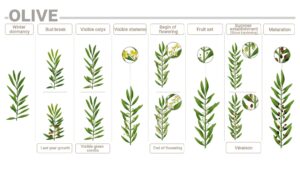Potassium deficiency in olive trees is expressed by older leaves' chlorosis that starts on their tips and progresses towards the leaves' the leaf base, in severe cases this chlorosis develops into necrosis with the same evolving pattern. Affected leaves also show reduced size, and their tips tend to curve downwards. These symptoms are particularly prevalent during fall and winter. However, potassium deficiency diagnosis is not guaranteed based on these symptoms, and it must be further confirmed by leaf analysis. Deficient leaves contain about 0,1%–0,3% potassium (on a dry basis), whereas the content of well-supplied leaves ranges 0,4%–1,7%. Severe deficiency will cause twig die-back, reduced fruit number and smaller fruit size. Since the potassium cation (K+) is rather mobile in both the xylem and the phloem transport systems of the plant, and since the plant is programmed to prefer the development of young tissues, the tendency in most plants is to extract the K from the old organs and tissues, and to pass it to the newer ones. This is the reason for the general phenomenon that K deficiency shows up firstly on the older and more mature foliage of the plant.
Artículos
Symptoms of potassium deficiency in olive trees
Related Crops



